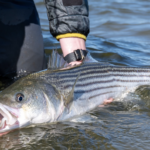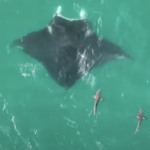
Talkin’ Striped Bass Spawn Dynamics
Consistent spawning production is paramount to a fishery’s long-term health. Many environmental factors are suspected
On the morning of Tuesday, December 14th, the Mid-Atlantic Fishery Management Council (Council) met jointly with the Atlantic States Marine Fisheries Commission’s (Commission) Summer Flounder, Scup, and Black Sea Bass Board (Board) to consider several issues within the black sea bass, summer flounder, and scup fisheries. Ten hours later, the group finalized decisions for all the agenda items, but it’s fair to say that no one walked away thrilled. The meeting was dominated by difficult questions of allocation, accountability, and applicability of the Magnuson-Stevens Act.
The issues at hand were setting the recreational measures for the three species in 2022 and final action on the Summer Flounder, Scup, and Black Sea Bass Commercial/Recreational Allocation Amendment, which will be implemented in 2023. As we go through what happened during the meeting, just remember—none of these decisions are easy, especially with issues of reallocation. There are unavoidable winners and losers, one of the reasons why we try to avoid these disputes as much as possible and focus instead on maintaining the long-term health of the resource at hand.
2022 Recreational Measures
Back in August, the Council and Board set the 2022 specifications for these species—the total poundage of fish that the commercial and recreational sectors could respectively catch based on recent stock assessments. But they needed to approve recreational management measures that would not be expected to exceed those previously set limits (the Recreational Harvest Limit, or RHL) while accounting for recent fishery performance.
This year’s process was complicated by past decisions to keep measures status quo for 2021 due to 2020 data limitations from COVID-19 despite indications of some recreational overages. For scup and black sea bass, based on the best catch data we have, anglers have caught considerably more fish than their limits from 2018-2021 on average. And based on those estimates, recreational anglers were expected to exceed the RHLs for 2022 by 39% for black sea bass and a whopping 122% for scup, if status quo measures were approved.
According to these fisheries’ management plans, managers must address the overages and modify the recreational management measures to not exceed RHLs. Council and Commission staff found that measures could potentially be liberalized by 33% for summer flounder because recreational harvests had been below the RHL for the past three years—although they emphasized caution with that level of liberalization. But reductions would be needed for black sea bass and scup in order to prevent 2022 RHL overages. Staff recommended a 28% harvest reduction for black sea bass and a 56 % harvest reduction for scup—which, unsurprisingly, generated a lot of controversy.
Now, you may be thinking: “Why do we care? Aren’t both the scup and black sea bass populations healthy?” The reason why we care, in short, is because those reductions are a requirement of the Magnuson-Stevens Act (MSA)—the law that has effectively managed our fisheries for decades—and violating its requirements would undermine the management framework that has been successful in both recovering and sustaining numerous species (including, yes, black sea bass and scup). It’s worth mentioning that a root cause for recent recreational overages—and the need for reductions now—is the inherent difficulty of accurately predicting, estimating and monitoring recreational catch, a topic we discussed this past summer. The challenges associated with recreational catch accounting given the tools currently in hand makes the role of precautionary management for the recreational sector all the more necessary. Managers cannot just flip a switch when they want to follow the law or when they want to ignore it, or when they want to employ the best available science. Unfortunately, there was a lot of that during the meeting.
The Council and Board were quick to approve a 16.5% liberalization in the summer flounder fishery, despite signs of decline in recruitment. Recruitment has remained generally below average this past decade, and the reason is not known.

When it came to recreational reductions for scup and black sea bass, the staff recommendations were disputed tooth and nail. Both the monitoring committee, “which is responsible for annually reviewing the best available data and recommending commercial and recreational measures designed to assure that the target mortality level for each fishery managed under the FMP is not exceeded,” and some Council and Board members sought to advance measures that would exceed 2022 RHLs for these species, but to do so through “compromise.” The reality is that compromise is not always a viable alternative for MSA requirements. Simply put, the Council had to adopt measures that would prevent an overage; there were no ways to justify status quo measures for another year. Without a doubt, we recognize the challenges these reductions may impose on some businesses whose clients hope to harvest these food fish. From our perspective, however, the need to bite the bullet now comes as a result of both not being more precautionary sooner and not being as reactive to overharvest in previous years.
Eventually, Mike Pentony, the Regional Administrator of NOAA Fisheries’ Greater Atlantic Region, had no other option but to threaten a federal waters closure of scup and black sea bass to prevent overages in 2022 if managers did not adopt measures that achieved the needed reductions. Unlike the Commission, which manages these species in state waters, the Councils have to set regulations that comply with MSA and are ultimately approved by the Secretary of Commerce, who oversees NOAA. A federal waters closure would have been the only lever to prevent 2022 overages, which would have disproportionately harmed the southern states that primarily harvest black sea bass in federal waters, but it was now on the table.
Ultimately, the Council and Board adopted a 33% reduction for scup, despite staff—and MSA—calling for a 56% reduction to prevent an overage. For black sea bass, lesser reductions than the needed 28% were attempted, but the threat of federal closures, which would essentially eliminate the recreational fishery south of New Jersey, proved influential. Ultimately, the Council and Board voted to take the needed action and adopted a 28% reduction.
While the legally and scientifically sound option was approved for black sea bass, it was not for scup, and a more troubling issue came to light during this specifications process. Both scup and black sea bass monitoring committees recommended recreational measures projected to result in RHL overages—fairly significant ones too.
That concerns us for several reasons. For one, the law is the law, and selectively applying MSA is not an option. While scup and black sea bass, to be sure, are doing well, it’s not a stretch to see how some of the arguments put forth at the meeting could be extended to those species with an outlook that’s perhaps not quite as rosy. Toward that end, it’s worth reemphasizing that both RHLs and Annual Catch Limits (ACLs) are science-based tools managers use to prevent overfishing; adhering to them means positioning fisheries for long-term health. Finally, there’s the equity issue that came up a handful of times during the meeting (and is indeed MSA’s fourth national standard); why should the commercial fishermen be held strictly accountable, when Council and Committee members knowingly and consistently let the recreational sector exceed its limits? In this case, the outcome of slowly eroding the MSA points to unsustainable fisheries and even more volatile swings in fishery performance.
Just look at what Council staff wrote in their black sea bass memo (the same holds true for all Council-managed species): “The recreational ACL and the RHL are based on the best available science, are intended to prevent overfishing, and are reflective of recent stock status. Therefore, allowing multiple years of recreational overages may pose a risk to the stock, even at high biomass levels.” Now that the Council and Board approved liberalizations with summer flounder and reductions for scup and black sea bass, states will now use conservation equivalency to put forward corresponding bag, size, and season limits.
Final Action on Reallocation
The Reallocation Amendment was controversial and, to be frank, emotional. This was not unexpected, because no one wants a smaller piece of the pie, especially with these three species that are largely viewed as food fish. When MRIP estimates dating back to 1981 were revised in 2018 due to a change in methodology, our understanding of recreational fisheries changed. Managers realized that the recreational sector was catching more fish than previously estimated, thus there were more fish in the ocean. This contributed to the Council and Commission revisiting the current allocations, namely considering an increase in recreational allocation at the expense of commercial allocation to better reflect what had actually been happening on the water given the new MRIP estimates.
Unsurprisingly, members of the commercial sector were vocal proponents of maintaining the status quo. The Amendment was positive in the sense that managers could move to catch-based accounting, which considers each sector’s discards in allocation. On the other hand, the amendment and discussion were painful, because one sector was clearly going to lose. Like we said earlier, we don’t enjoy these allocation fights. If you’re interested about the new allocations, which will be implemented beginning in 2023 here is the MAFMC press release, and the new allocations are pasted below:

While the reallocation outcome was the culmination of a long and unpleasant—but much-needed—process, the outcomes for 2022 measures for scup set a dangerous precedent for holding recreational fisheries accountable. While the Mid-Atlantic Council was long a stalwart proponent of conservation-oriented management approaches, we can only hope that this isn’t the beginning of a slippery slope that puts short-term interests ahead of both long-term resource health and the foundational law for our nation’s fisheries.

Consistent spawning production is paramount to a fishery’s long-term health. Many environmental factors are suspected

While the ASGA team is extremely proud of the community we’re building with the Guide

Feature Image: A false albacore being landed off Jupiter Florida by the Cheeky Fishing team,

Feature Photo: “Best Practices for Fishing Cobia Around Manta Rays” The Florida Manta Project is
We rely on our members and donations to keep fighting for a sustainable tomorrow in marine conservation.
By using this website, you agree to our use of cookies. We use cookies to provide you with a great experience and to help our website run effectively. To learn more, please review our privacy policy.
3 Responses
We all understand there have been significantly more unforeseen recreational anglers in general (covid effect) and it would make sense to me that there was a significantly higher recreational harvest – but what methods are these people using to obtain their “actuals”. i don’t think i have ever been surveyed in any way with regards to a scup, bsb, or fluke catch statistics (???)
Commercial fishing techniques are destroying the grounds these fish rely on throughout the summer months in Rhode Island. It’s sad when you see 5 draggers going back and forth less than 2 miles from shore in front of Misquamicut everyday day of the week. Commercial net fishing needs to end, give them a rod and reel.
“The Council and Board were quick to approve a 16.5% liberalization in the summer flounder fishery, despite signs of decline in recruitment. Recruitment has remained generally below average this past decade, and the reason is not known.”
Apparently you need to be blind and or incompetent to be part of fisheries management. Recreational size limit increases destroyed this fishery and NMFS won’t admit it until it’s too late. Identify another fishery that targets the harvest of the spawning stock with a preference for large female breeders, kills recruitment in the process, operates at unprecedented levels of discard mortality and provided no protection to the spawn and then tell me how ASA. NMFS or anyone else can make the statement recruitment has been below average for years and the reason is unknown.
Between 2010 and 2017, 50% or over 30 million mature female breeders were removed from the stocks population, size of the breeding stock in metric tons declined by 40%, recruitment has retested 1980’s levels and landing weights which averaged 1.85 lbs between sectors were 4.2 lbs in 2017, more than double. The regulations are killing the future of this fishery while everyone plays politics.